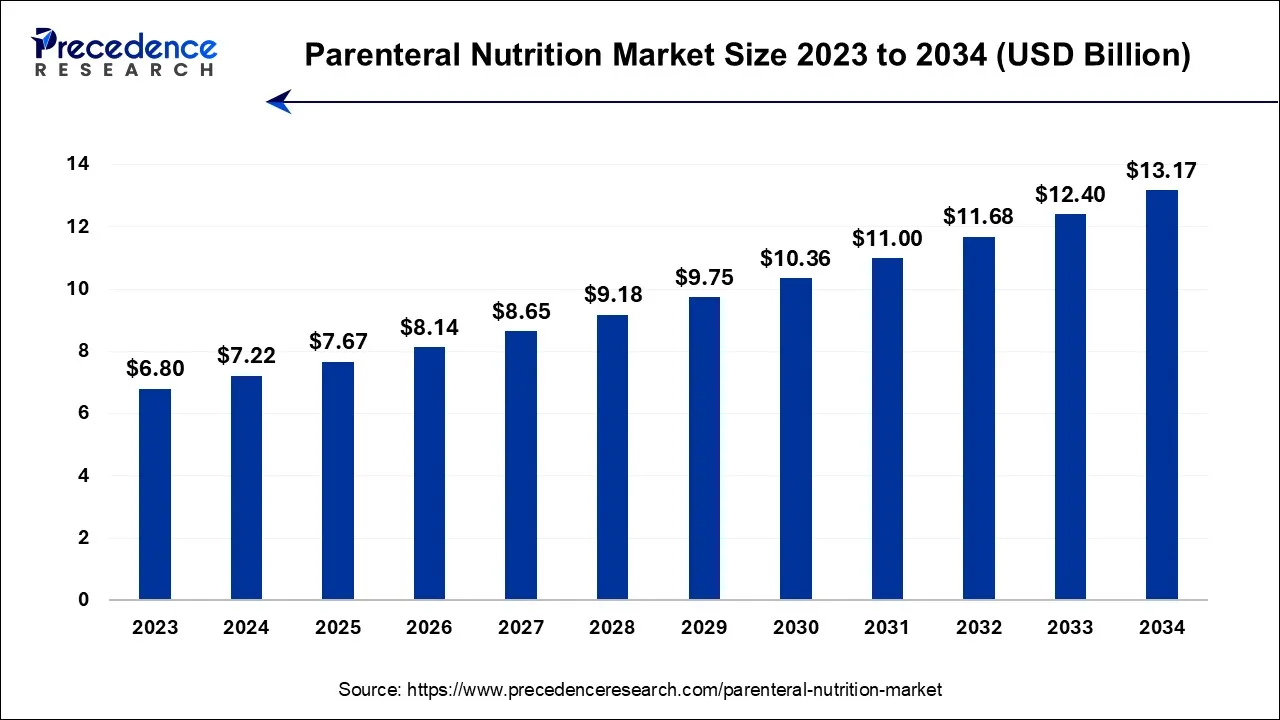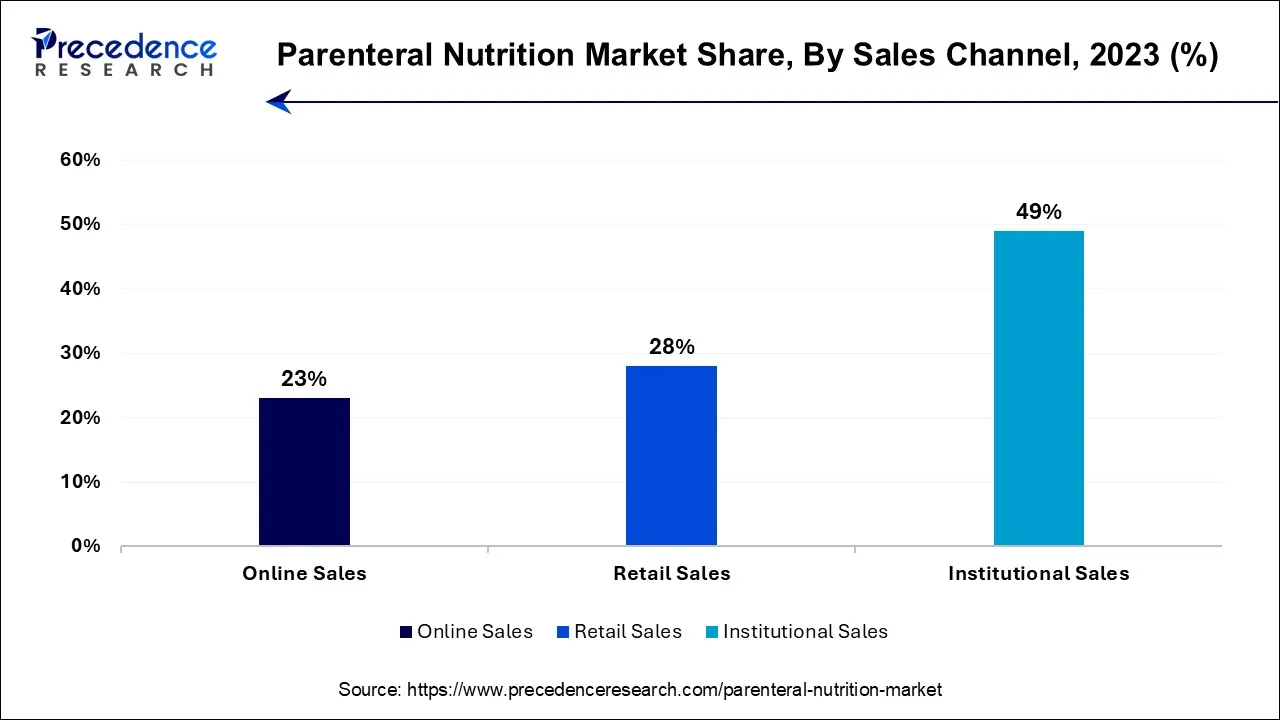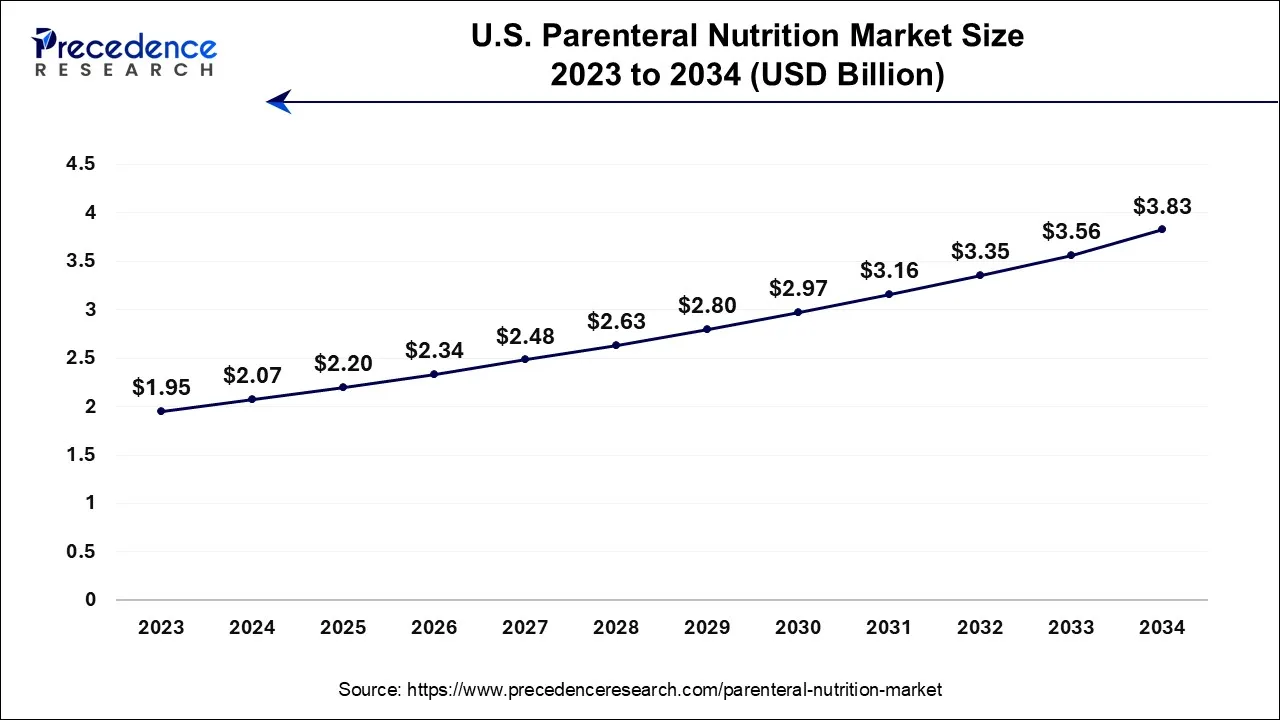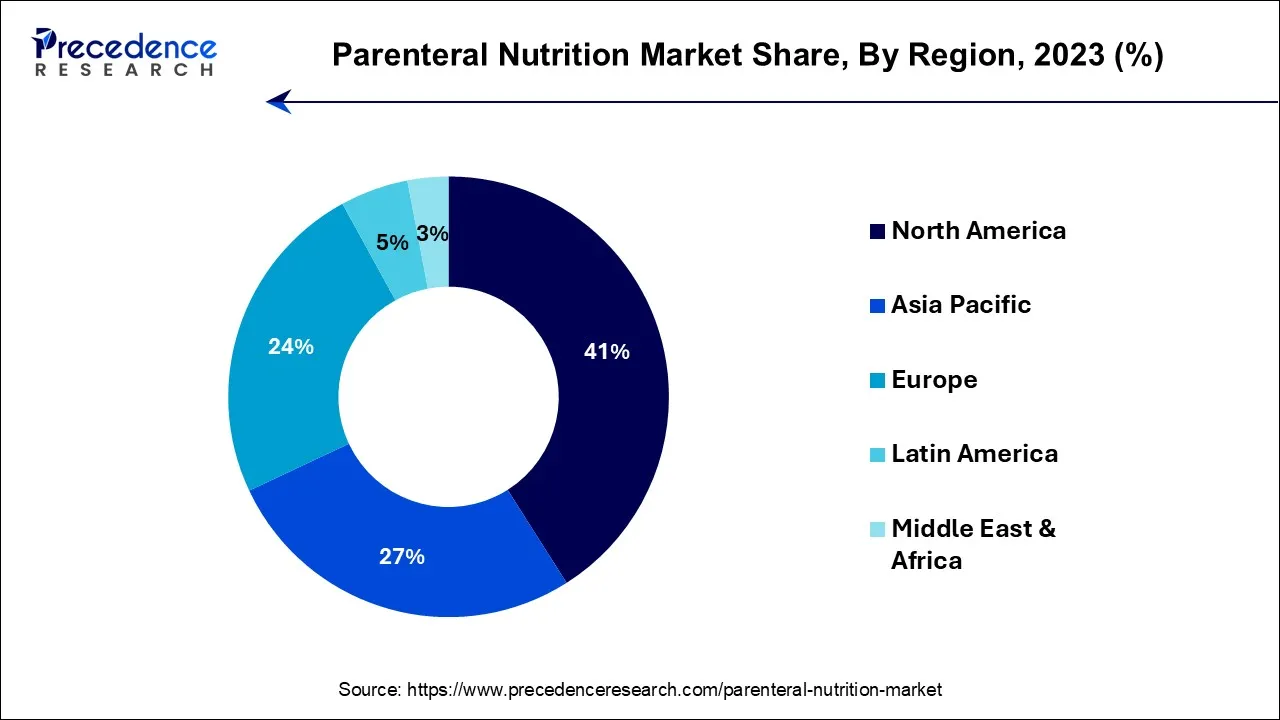What is Parenteral Nutrition Market Size?
The global parenteral nutrition market size is expected to be valued at USD 7.67 billion in 2025 and is anticipated to reach around USD 13.17 billion by 2034, expanding at a CAGR of 6.2% over the forecast period from 2025 to 2034.

Market Highlights
- North America dominated the market with the highest market share of 41% in 2024.
- Asia-Pacific is expected to expand at the fastest CAGR during the forecast period.
- By Nutrient Type, the single-dose amino acid solution segment has held the biggest revenue share of 31% in 2024.
- By Nutrient Type, the trace elements segment is estimated to grow at a notable CAGR of 8.1% during the projected period.
- By Stage Type, the adult segment captured more than 85% of revenue share in 2024.
- By Stage Type, the single touch segment is projected to expand at the fastest CAGR over the projected period.
- By Indication, the other segment contributes the largest revenue share of 31% in 2024.
- By Indication, the alzheimer's segment is estimated to grow at a remarkable 9.9% over the predicted period.
- By Sales Channel, the institutional sales channel segment generated more than 49% in 2024.
- By Sales Channel, the online sales segment is projected to expand at a remarkable CAGR of 11.8% over the predicted period.
Market Overview
The parenteral nutrition market denotes the global sector dedicated to delivering vital nourishment through intravenous means, catering to individuals who cannot orally ingest food or absorb nutrients through their digestive tract. It encompasses a diverse array of products, including parenteral nutrition solutions, infusion apparatus, and associated accessories. Growth in this sector is propelled by factors such as an aging demographic, a rising incidence of chronic ailments, and advancements in healthcare infrastructure. It is a fiercely competitive arena where prominent participants, including pharmaceutical firms, medical equipment producers, and healthcare service providers, vie to fulfill the nutritional requirements of patients.
Parenteral Nutrition Market Growth Factors
The realm of parenteral nutrition constitutes a pivotal sector in healthcare, specializing in the intravenous delivery of essential nutrients to individuals who are unable to partake in oral nutrition or nutrient absorption through their gastrointestinal tract. Within this global market, a diverse array of products, including parenteral nutrition formulations, infusion apparatus, and associated adjuncts, is harnessed to fulfill the nutritional requirements of patients.
Numerous prevailing trends and catalysts for growth exert a profound influence on the parenteral nutrition market. A salient demographic factor is the aging global populace, whose nutritional needs often necessitate the administration of parenteral nutrition due to underlying medical conditions. Furthermore, the escalating incidence of chronic ailments, encompassing cancer and gastrointestinal disorders, has precipitated an uptick in demand for parenteral nutrition solutions. Concomitantly, advancements in healthcare infrastructure and technology, marked by the refinement of parenteral nutrition formulations and administration modalities, are instrumental in propelling market expansion.
Despite its burgeoning prospects, the parenteral nutrition arena confronts its share of challenges. The intricate landscape of regulations and stringent quality standards can present formidable obstacles for manufacturers and healthcare providers alike. The potential for infection associated with intravenous nutrition delivery systems necessitates scrupulous adherence to rigorous hygiene and safety protocols. Moreover, the cost factor looms large, rendering parenteral nutrition less attainable for certain segments of the patient populace, especially in emerging economies.
Notwithstanding the hurdles, substantial business prospects are discernible within the parenteral nutrition market. Pioneering innovations in parenteral nutrition formulations and delivery mechanisms, such as personalized nutritional solutions and intelligent infusion devices, are poised to be pivotal drivers of growth. Additionally, venturing into burgeoning markets characterized by evolving healthcare infrastructure holds the promise of robust returns for market participants. Synergistic collaborations among pharmaceutical entities, medical device manufacturers, and healthcare providers have the potential to yield comprehensive solutions tailored to the unique needs of patients necessitating parenteral nutrition.
In summation, the parenteral nutrition domain occupies a pivotal niche in healthcare, catering to individuals with intricate nutritional exigencies. Market expansion hinges on demographic shifts, the ascendancy of chronic ailments, and technological progress, despite regulatory and cost-related impediments. To seize the opportunities inherent in this arena, stakeholders should orient themselves toward innovation and global outreach, fostering partnerships that enhance patient care and broaden access to parenteral nutrition interventions.
Parenteral Nutrition Market Outlook
- Industry Growth Overview: The parenteral nutrition market is expected to experience substantial growth from 2025 to 2034, driven by the rising prevalence of chronic diseases, an increasing geriatric population, and a higher incidence of malnutrition. Advances in medical technologies and increasing healthcare spending also support this expansion.
- Customized and Compounded PN Formulations: A major trend is the shift toward customized and compounded PN formulations to meet specific patient nutritional needs. The expansion of home parenteral nutrition (HPN) is another crucial trend, driven by cost-effective care and patient comfort. Additionally, advancements in PN bag design and automated compounding improve safety and accuracy.
- Global Expansion: The market is expanding worldwide, with significant opportunities in emerging regions. Increasing healthcare investments, a high burden of chronic diseases, and growing awareness of malnutrition in emerging regions are driving demand for nutritional support solutions.
- Major Investors: Large healthcare and pharmaceutical corporations, including Baxter International Inc., B. Braun Melsungen AG, Fresenius Kabi AG, and Pfizer Inc., are the primary investors. Investment is also significantly driven by government and private initiatives to improve patient care standards and nutritional therapy programs.
- Startup Ecosystem: A vibrant startup ecosystem is emerging, focusing on niche innovations in software and specialized delivery hardware. Startups are attracting funding to develop unique platforms, such as AI-driven software for optimal PN prescriptions and advanced remote patient monitoring systems for HPN.
Market Scope
| Report Coverage | Details |
| Market Size in 2025 | USD 7.67 Billion |
| Market Size in 2026 | USD 8.14 Billion |
| Market Size by 2034 | USD 13.17 Billion |
| Growth Rate from 2025 to 2034 | CAGR of 6.2% |
| Largest Market | North America |
| Base Year | 2024 |
| Forecast Period | 2025to 2034 |
| Segments Covered | By Nutrient Type, By Stage Type, By Indication, and By Sales Channel, and region |
| Regions Covered | North America, Europe, Asia-Pacific, Latin America, and Middle East & Africa |
Market Dynamics
Drivers
Shortage of nutrient absorption
The deficiency in nutrient assimilation stands as a pivotal instigator propelling the burgeoning of the parenteral nutrition market. Assorted medical conditions and gastrointestinal disorders, including the likes of short bowel syndrome, inflammatory bowel ailment, and post-surgical complications, can profoundly hinder the organism's capacity to extract vital nourishment from customary dietary intake. In such scenarios, parenteral nutrition assumes an irreplaceable role by enabling the direct intravenous infusion of essential nutrients, circumventing the compromised digestive processes. This dependence on parenteral nutrition is on an unwavering ascent, driven by the mounting incidence of these conditions and a maturing population predisposed to the emergence of gastrointestinal afflictions over time.
Patients grappling with the intricacies of nutrient absorption challenges necessitate the careful tailoring of intravenous nutritional regimens to preserve their well-being and mitigate the specter of malnutrition-related complications. Furthermore, ongoing scientific explorations perpetually augment parenteral nutrition formulations, rendering them progressively efficacious and individualized to cater to the unique requisites of each patient. Consequently, healthcare providers are progressively embracing parenteral nutrition as an inescapable therapeutic recourse, thus vigorously propelling the parenteral nutrition market's growth in response to the burgeoning clamor for these life-sustaining interventions.
Restraints
Nutritional imbalance
Nutritional imbalance constitutes a substantial impediment to the expansion of the parenteral nutrition market. While parenteral nutrition remains indispensable for individuals with compromised nutrient absorption, it falls short of replicating the intricate nutritional harmony found in a well-rounded diet. The intravenous administration of nutrients may not encompass the full spectrum of micronutrients and bioactive compounds present in whole foods, potentially engendering enduring nutritional asymmetry. This deficiency in comprehensive nutrient provision can give rise to an array of complications, encompassing deficiencies in vitamins and minerals, metabolic irregularities, and impairments in organ function. Healthcare practitioners must meticulously oversee and fine-tune parenteral nutrition protocols to ameliorate these perils, augmenting the intricacy and cost of treatment.
Additionally, patients may grapple with unfavorable repercussions linked to nutritional imbalances, adversely affecting their overall health. This limitation has spurred a predilection for enteral nutrition whenever feasible, as it enables the conveyance of nutrients through the gastrointestinal tract, a process more closely aligned with the body's natural physiological rhythms. Consequently, the adoption of parenteral nutrition may be circumscribed in scenarios where alternative methodologies can be employed, thereby influencing the market's growth prospects.
Opportunities
Innovation in formulations
Revolutionary strides in formulation innovation present a pivotal avenue of opportunity within the parenteral nutrition market. These innovations usher in a new era of tailored and highly specialized nutritional solutions, meticulously crafted to precisely align with the unique needs and medical conditions of individual patients. This degree of customization not only enhances the efficacy of parenteral nutrition but also elevates patient outcomes and overall satisfaction. Innovations in formulations empower the market to comprehensively address the distinctive nutritional demands of diverse patient demographics, ranging from neonates and geriatric individuals to those grappling with specific medical ailments.
For instance, the development of lipid-based emulsions featuring heightened stability and enhanced bioavailability is reshaping the landscape of intravenous nutrition, particularly in the care of premature infants. Furthermore, these formulation advancements are instrumental in mitigating the inherent risks of complications and adverse effects that have historically been associated with conventional nutritional solutions. This dual benefit of optimizing patient care while fostering greater acceptance of parenteral nutrition within the healthcare ecosystem positions the market for remarkable growth and enduring success.
Segment Insights
Nutrient Type Insights
According to the Nutrient Type, the single-dose amino acid solution sector has held a 31% revenue share in 2023. The dominant share held by the single-dose amino acid solution segment in the parenteral nutrition market can be attributed to several compelling factors. Notably, it offers precise and user-friendly dosing methods, mitigating the potential for dosage errors. In critical care environments where stringent aseptic conditions are imperative, single-dose solutions are favored, enhancing patient safety and reducing contamination risks. These solutions exhibit versatility, effectively addressing a broad spectrum of medical conditions, including malnutrition, cancer, and gastrointestinal disorders, thus expanding their applicability. Moreover, their straightforward administration and storage advantages further bolster their appeal and substantial presence within the market.
The trace elements sector is anticipated to expand at a significant CAGR of 8.1% during the projected period. The Trace Elements segment holds a significant share in the parenteral nutrition market due to its crucial role in supporting various physiological functions. Trace elements like zinc, copper, selenium, and chromium are essential for metabolic processes, immune function, and tissue repair. They are particularly vital for critically ill patients with impaired absorption or increased losses. As a result, healthcare providers prioritize the inclusion of trace elements in parenteral nutrition formulations, driving the demand for these specialized products and contributing to their major share in the market.
Stage Type Insights
Based on the stage type, the adult is anticipated to hold the largest market share of 85% in2023. The dominance of the adult segment in the parenteral nutrition market is attributed to the heightened occurrence of medical ailments among adults who mandate intravenous nutritional intervention. Conditions like cancer, gastrointestinal disorders, and post-operative complexities are notably more prevalent in adult populations, fueling the demand for parenteral nutrition solutions. The aging demographic, with its susceptibility to age-associated health challenges and chronic diseases, further amplifies this segment's significance. Additionally, the extended duration of parenteral nutrition therapy often required by adults contributes to their substantial market presence when compared to pediatric patients.
On the other hand, the single touch sector is projected to grow at the fastest rate over the projected period. The dominant growth of the pediatrics segment in the parenteral nutrition market can be attributed to several compelling reasons. Children grappling with conditions that hinder their normal nutrient absorption often necessitate intravenous nutritional support. Moreover, neonatal intensive care units (NICUs) heavily rely on parenteral nutrition to sustain prematurely born or critically ill infants. The segment's prominence is further underscored by the escalating demand for specialized pediatric formulations and the increasing prevalence of pediatric ailments, particularly gastrointestinal disorders. Consequently, the Pediatrics segment stands as a pivotal driver in propelling the overall growth trajectory of the parenteral nutrition market.
Indication Insights
The other segment held the largest revenue share of 31% in2023. The "others" segment, encompassing various health ailments like Crohn's disease, cystic fibrosis, pancreatitis, cancer-related treatments, and other medical conditions, commands a substantial share in the parenteral nutrition market. This is primarily due to patients battling these ailments often requiring intensive therapies such as radiation therapy, immunotherapy, and medication. These treatments can compromise their ability to consume and absorb nutrients orally, making intravenous nutrition support, provided by parenteral nutrition, a crucial lifeline. Hence, the demand for parenteral nutrition in this patient population significantly contributes to the segment's prominence within the market.
The Alzheimer's sector is anticipated to grow at a significantly faster rate, registering a CAGR of 9.9% over the predicted period. The dominant share of the Alzheimer's segment within the parenteral nutrition market can be attributed to the distinctive nutritional demands posed by Alzheimer's disease. The condition frequently leads to profound cognitive decline, rendering self-feeding and dietary management challenging. Consequently, parenteral nutrition assumes a pivotal role in directly supplying essential nutrients, ensuring that Alzheimer's patients receive the requisite nourishment. The escalating global prevalence of Alzheimer's within aging demographics has accentuated the demand for parenteral nutrition in this specific context, solidifying its prominent position in the market landscape.
Sales Channel Insights
The institutional sales channel segment has generated a revenue share of 49% in2023. The institutional sales channel segment dominates the parenteral nutrition market due to several key factors. Hospitals, clinics, and healthcare institutions are the primary providers of parenteral nutrition therapy, especially for critically ill patients and those with complex medical conditions. These facilities have established infrastructure, trained medical staff, and the capacity to handle intravenous therapies effectively. Additionally, the institutional segment benefits from bulk purchasing, economies of scale, and the ability to provide comprehensive care, making it the preferred channel for the procurement and administration of parenteral nutrition products.

The Online Sales segment is anticipated to grow at a significantly faster rate, registering a CAGR of 11.8% over the predicted period. The online sales segment has garnered a significant share in the parenteral nutrition market due to several factors. Firstly, it offers convenience and accessibility, allowing healthcare professionals and patients to procure essential parenteral nutrition products quickly and efficiently. Moreover, the COVID-19 pandemic accelerated the adoption of online platforms for healthcare purchases, including parenteral nutrition, as it minimized physical contact. Additionally, the online channel often provides a wider range of product options, competitive pricing, and the ability to compare brands and features, further driving its popularity and market share in the parenteral nutrition industry.
Regional Insights
U.S. Parenteral Nutrition Market Size and Growth 2025to 2034
The U.S. parenteral nutrition market size is accounted for USD 2.20 billion in 2025 and is projected to be worth around USD 3.83 billion by 2034, poised to grow at a CAGR of 6.35% from 2025 to 2034.

U.S. Parenteral Nutrition Market Trends
The U.S. leads the parenteral nutrition market in North America by emphasizing technological innovation, advanced formulations, and home-based care, supported by a mature healthcare infrastructure and high rates of chronic disease. The country is home to a large number of market players. These players foster innovation in nutrient delivery and advanced lipid emulsions, while government programs work to address malnutrition.
What Made North America the Dominant Region in the Parenteral Nutrition Market?
North America has held the largest revenue share 41% in 2023. North America commands a substantial share of the parenteral nutrition market owing to its mature healthcare infrastructure, substantial healthcare investments, and a sizable elderly demographic with intricate medical requirements. Furthermore, the region's prominence is reinforced by a significant presence of key industry participants, ongoing research and development endeavors, and a favorable regulatory milieu. North America's commitment to pioneering solutions, alongside a high incidence of chronic illnesses and the integration of cutting-edge healthcare technologies, underscores its pivotal role in the parenteral nutrition market, cementing its status as a leading contributor to the sector's overall revenue.

What Makes Asia Pacific the Fastest-Growing Region in the Parenteral Nutrition Market?
Asia-Pacific is estimated to observe the fastest expansion. The Asia-Pacific region has asserted a dominant position in the parenteral nutrition market, influenced by several distinctive factors. Foremost, the region's expansive populace, notably in countries such as China and India, has fostered a substantial patient base necessitating parenteral nutrition interventions. Furthermore, continuous enhancements in healthcare infrastructure and escalating healthcare expenditures have spurred the adoption of advanced medical therapies, including parenteral nutrition. The prevalence of a substantial aging demographic beset by age-related health challenges has further propelled demand. Lastly, the heightened recognition of the advantages of parenteral nutrition and augmented governmental support for healthcare initiatives have propelled robust market expansion within the Asia-Pacific realm.
India Parenteral Nutrition Market Trends
India is a rapidly growing market driven by efforts to increase affordability and accessibility in order to combat widespread malnutrition and chronic diseases. Supported by strong government initiatives and an expanding healthcare system, the market is evolving quickly as both local and global companies tailor their products to meet regional needs. This focus on localization and reaching a large, underserved population is accelerating overall market growth.
How is Europe Emerging in the Parenteral Nutrition Market?
Europe is growing at a notable rate in the market. The market in Europe is defined by advanced healthcare infrastructure, increased patient awareness about nutritional support, and a large aging population dealing with chronic conditions. The market is mainly driven by strong clinical guidelines, a focus on home healthcare for patient convenience using multi-chamber bags, and significant research and development. Leading industry players invest heavily in improving lipid emulsions and ensuring the safe and stable preparation of total parenteral nutrition solutions.
Germany Parenteral Nutrition Market Trends
Germany is a major contributor to the parenteral nutrition market due to its renowned healthcare system and dedication to high-quality medical care and personalized treatments. The country acts as a hub for research and development in specialized parenteral nutrition formulas and advanced delivery systems, showing a high adoption rate of both standardized multi-chamber bags and custom-compounded solutions. The market is heavily influenced by global leaders like B. Braun and Fresenius Kabi, who promote safe and effective parenteral nutrition therapies.
How is the Opportunistic Rise of Latin America in the Parenteral Nutrition Market?
Latin America is experiencing an opportunistic rise in the market, driven by increased government investment in public health, expanded hospital infrastructure, and growing awareness of clinical malnutrition. The region's large population and rising incidence of chronic illnesses necessitate strengthening nutritional support capabilities, particularly by improving accessibility and health outcomes for malnourished patients across both public and private healthcare systems.
Brazil Parenteral Nutrition Market Trends
The market in Brazil is driven by substantial investments in healthcare infrastructure to address high malnutrition rates among hospitalized patients and the post-operative care needs of its population. The demand for precise and prompt nutritional support is fueling the adoption of advanced parenteral nutrition formulations and delivery systems in both public and private healthcare sectors.
What Potentiates the Growth of the Middle East & Africa Parenteral Nutrition Market?
The market in the Middle East & Africa is driven by rapid progress in healthcare infrastructure, rising health expenditures, and a strong emphasis on specialized hospital care and medical tourism. The need for reliable, high-quality parenteral nutrition solutions remains strong, especially for managing complex surgical recoveries and chronic illnesses. This growth is supported by large investments in smart city projects that incorporate comprehensive health facilities, aiming to offer high-quality, globally recognized healthcare services.
UAE Parenteral Nutrition Market Trends
The UAE plays a crucial role in the parenteral nutrition market, fueled by its bold technological initiatives and smart health projects. The country is making significant investments in cutting-edge hospital facilities and advanced health screening programs. There is also a growing demand for premium parenteral nutrition applications in critical care units, specialized clinics, and home healthcare settings, boosting the adoption of innovative parenteral nutrition solutions with improved patient health outcomes.
Value Chain Analysis
- Research & Development (R&D)
This involves innovating nutrient combinations (carbohydrates, lipids, etc.) to enhance stability and safety.
Key Players: B. Braun Melsungen, Fresenius Kabi, Baxter, Otsuka, and Pfizer. - Manufacturing and Production
This involves the sterile production of individual components and compounding them with stringent quality control.
Key Players: Baxter, Fresenius Kabi, B. Braun Melsungen, and Otsuka. - Clinical Testing and Regulatory Approval
New formulations require rigorous clinical trials and regulatory approvals from bodies such as the FDA and EMA.
Key Players: IQVIA, ICON plc, Parexel, PPD, and Labcorp Drug Development. - Service Delivery
PN is prescribed, formulated, and administered in hospitals, clinics, and the rapidly growing home care setting.
Key Players: Option Care Health Inc. and Optum, Inc.
Top Companies in the Parenteral Nutrition Market
- Baxter: Leader in pre-mixed multi-chamber bags (e.g., Clinimix, Olimel) for convenience and reduced contamination risk.
- Fresenius Kabi: Offers a wide range of customizable multi-chamber bags (e.g., SmofKabiven) and individual components with a focus on affordability and quality.
- B. Braun Melsungen: Provides integrated therapy systems, combining PN products with innovative infusion management technology for enhanced safety.
- Grifols: Specializes in PN products with enhanced stability and bioactive components, leveraging its expertise in plasma derivatives.
- Otsuka Pharmaceutical Factory: Offers research-driven, specialized nutritional formulations with a strong focus on pediatric and neonatal care.
Other Key Players
- Allergan
- Actavis Inc.
- Vifor Pharma
- Sichuan Kelun Pharmaceutical Co., Ltd.
- Pfizer Inc. (Hospira Inc.)
Recent Developments
- In November 2022, the Indian Society for Parenteral and Enteral Nutrition (ISPEN) officially endorsed the web-based application called iNutrimon. This application is designed to assist healthcare professionals in delivering optimal nutrition to patients who are in the process of recovery within healthcare facilities.
- In February 2022,Pharmasyntez, a pharmaceutical company, made an announcement regarding its investment.
Segments Covered in the Report
By Nutrient Type
- Carbohydrates
- Parenteral Lipid Emulsion
- Single Dose Amino Acid Solution
- Trace Elements
- Vitamins & Minerals
By Stage Type
- Adult
- Pediatrics
By Indication
- Alzheimer's
- Nutrition Deficiency
- Cancer Care
- Diabetes
- Chronic Kidney Diseases
- Orphan Diseases
- Dysphagia
- Pain Management
- Malabsorption/GI Disorder/Diarrhea
- Others
By Sales Channel
- Online Sales
- Retail Sales
- Institutional Sales
By Region
- North America
- Europe
- Asia-Pacific
- Latin America
- Middle East and Africa
For inquiries regarding discounts, bulk purchases, or customization requests, please contact us at sales@precedenceresearch.com
Frequently Asked Questions
Ask For Sample
No cookie-cutter, only authentic analysis – take the 1st step to become a Precedence Research client




 sales@precedenceresearch.com
sales@precedenceresearch.com
 +1 804-441-9344
+1 804-441-9344